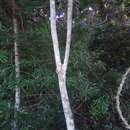en
names in breadcrumbs


Cnestis polyphylla, or itch pod, is a liane or scrambling shrub belonging to the family Connaraceae and occurring south from Kenya in East Tropical Africa through Mozambique and Zimbabwe to Southern Africa where it is found in coastal and escarpment forest in Limpopo, Mpumalanga, Eswatini and KwaZulu-Natal, and further south to the Eastern Cape. It also grows on the Indian Ocean islands of Madagascar, Mauritius and Réunion.[1] The genus has at least 13 species with many still unresolved. They are distributed mainly in tropical Africa and nearby islands, but extend to SE Asia and China.
Immature leaves are red, ranging through bronze, pale green, mid-green to bluish-green when mature. Leaves are imparipinnate and alternate, with oblong opposite leaflets, having an oblique base and blunt apex, 2.5 – 3 cm long and thinly pubescent below. The small, yellow flowers are crowded in small panicles. Sepals are softly pubescent. The almond-shaped capsule has a hornlike process at its tip, and dehisces by a longitudinal split when mature to reveal large, shiny, blackish-brown seeds with a basal yellowish aril. The capsules are covered inside and out with rigid reddish-brown hairs which penetrate human skin with ease and cause intense itching.[2][3]
All parts of the plant are rich in the potent neurotoxin glabrin, causing convulsions in most animals, and leading to its use as a fish poison. Extracts from the leaves are used for treating skin diseases. The protein methionine sulfoximine is common in the family Connaraceae and other toxic compounds have yet to be identified. The roots of some Connarus species are known to contain the glycosides rapanone, embelin and bergenin.[4][5][6]
Cnestis polyphylla, or itch pod, is a liane or scrambling shrub belonging to the family Connaraceae and occurring south from Kenya in East Tropical Africa through Mozambique and Zimbabwe to Southern Africa where it is found in coastal and escarpment forest in Limpopo, Mpumalanga, Eswatini and KwaZulu-Natal, and further south to the Eastern Cape. It also grows on the Indian Ocean islands of Madagascar, Mauritius and Réunion. The genus has at least 13 species with many still unresolved. They are distributed mainly in tropical Africa and nearby islands, but extend to SE Asia and China.
Immature leaves are red, ranging through bronze, pale green, mid-green to bluish-green when mature. Leaves are imparipinnate and alternate, with oblong opposite leaflets, having an oblique base and blunt apex, 2.5 – 3 cm long and thinly pubescent below. The small, yellow flowers are crowded in small panicles. Sepals are softly pubescent. The almond-shaped capsule has a hornlike process at its tip, and dehisces by a longitudinal split when mature to reveal large, shiny, blackish-brown seeds with a basal yellowish aril. The capsules are covered inside and out with rigid reddish-brown hairs which penetrate human skin with ease and cause intense itching.
All parts of the plant are rich in the potent neurotoxin glabrin, causing convulsions in most animals, and leading to its use as a fish poison. Extracts from the leaves are used for treating skin diseases. The protein methionine sulfoximine is common in the family Connaraceae and other toxic compounds have yet to be identified. The roots of some Connarus species are known to contain the glycosides rapanone, embelin and bergenin.
Cnestis polyphylla est une espèce de liane ou de buisson grimpant de la famille des Connaraceae. Elle est indigène de l'Est de l'Afrique tropicale, depuis le Kenya au Nord, jusqu'à l'Afrique australe, où elle vit dans les forêts côtières et d'altitude des provinces sud-africaines du Limpopo, Mpumalanga, Swaziland et KwaZulu-Natal, et plus au sud jusqu'au Cap Oriental. Elle pousse aussi dans certaines îles de l'Océan Indien, Madagascar, l'Île Maurice et La Réunion[2]. Le genre Cnestis compte au moins 13 espèces, plus d'autres encore non-définies. Celles-ci sont distribuées principalement en Afrique tropicale et dans les îles voisines, mais aussi en Asie du Sud-Est et en Chine.
Les jeunes feuilles sont rouges, allant du bronze au vert pâle, vert moyen ou bleu-vert quand elles sont matures. Ces feuilles sont imparipennées et alternes, avec des folioles opposées oblongues. Ces folioles de 2,5 à 3 cm de long ont une base oblique et une pointe obtuse et sont légèrement velues en dessous.
Les petites fleurs jaunes sont groupées en petits panicules. Leurs sépales sont légèrement pubescents. Leur capsule en forme d'amande se termine par un appendice ressemblant à une corne et s'ouvre par une fente longitudinale pour révéler de grosses graines brun-noir luisantes avec un arille jaunâtre. Ces capsules sont couvertes à l'extérieur et à l'intérieur de poils brun-rouge rigides qui pénètrent facilement dans la peau en causant des démangeaisons intenses[3],[4].
Toutes les parties de la plante sont riche en glabrine, une puissante neurotoxine qui provoque des convulsions chez la plupart des animaux, ce qui conduit à l'utiliser pour pêcher les poissons. Des extraits des feuilles sont utilisés pour traiter les maladies de peau. La méthionine-sulfoximine est commune dans la famille des Connaraceae et d'autres composés toxiques sont encore à identifier. Les racines de certaines espèces du genre Connarus (en) contiennent les glycosides rapanone, embeline et bergénine (en)[5],[6],[7].
Cnestis polyphylla est une espèce de liane ou de buisson grimpant de la famille des Connaraceae. Elle est indigène de l'Est de l'Afrique tropicale, depuis le Kenya au Nord, jusqu'à l'Afrique australe, où elle vit dans les forêts côtières et d'altitude des provinces sud-africaines du Limpopo, Mpumalanga, Swaziland et KwaZulu-Natal, et plus au sud jusqu'au Cap Oriental. Elle pousse aussi dans certaines îles de l'Océan Indien, Madagascar, l'Île Maurice et La Réunion. Le genre Cnestis compte au moins 13 espèces, plus d'autres encore non-définies. Celles-ci sont distribuées principalement en Afrique tropicale et dans les îles voisines, mais aussi en Asie du Sud-Est et en Chine.
Cnestis polyphylla là một loài thực vật có hoa trong họ Connaraceae. Loài này được Lam. mô tả khoa học đầu tiên năm 1789.[1]
Cnestis polyphylla là một loài thực vật có hoa trong họ Connaraceae. Loài này được Lam. mô tả khoa học đầu tiên năm 1789.